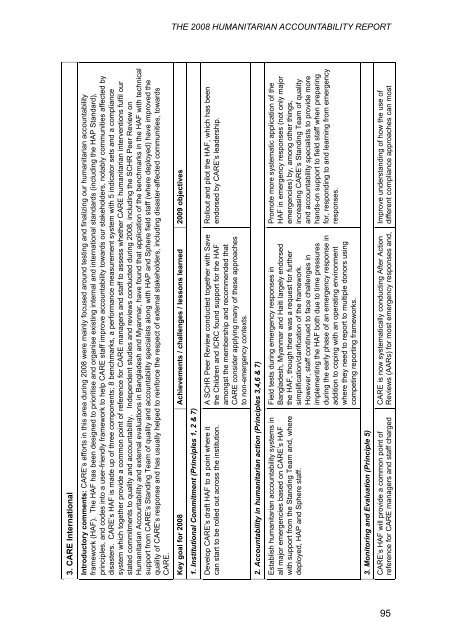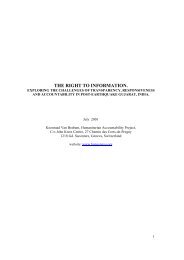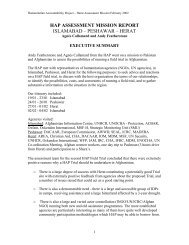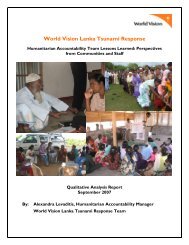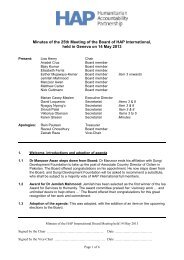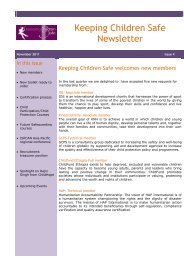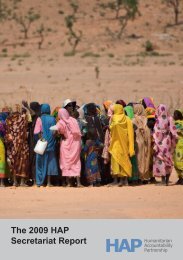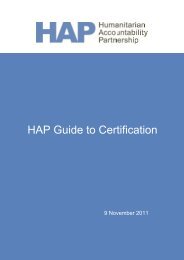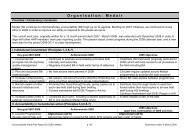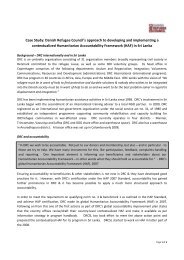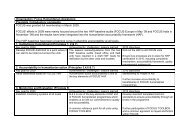Chapter Four - HAP International
Chapter Four - HAP International
Chapter Four - HAP International
You also want an ePaper? Increase the reach of your titles
YUMPU automatically turns print PDFs into web optimized ePapers that Google loves.
THE 2008 HUMANITARIAN ACCOUNTABILITY REPORT<br />
3. CARE <strong>International</strong><br />
Introductory comments: CARE’s efforts in this area during 2008 were mainly focused around testing and finalizing our humanitarian accountability<br />
framework (HAF). The HAF has been designed to prioritise and organise existing internal and international standards (including the <strong>HAP</strong> Standard),<br />
principles, and codes into a user-friendly framework to help CARE staff improve accountability towards our stakeholders, notably communities affected by<br />
disasters. CARE’s HAF is made up of three components; 8 benchmarks, a performance measurement system with 5 indicator sets and a compliance<br />
system which together provide a common point of reference for CARE managers and staff to assess whether CARE humanitarian interventions fulfil our<br />
stated commitments to quality and accountability. Independent studies and reviews conducted during 2008, including the SCHR Peer Review on<br />
Humanitarian Accountability and external evaluations in Bangladesh and Myanmar, have found that application of the benchmarks in the HAF with technical<br />
support from CARE’s Standing Team of quality and accountability specialists along with <strong>HAP</strong> and Sphere field staff (where deployed) have improved the<br />
quality of CARE’s response and has usually helped to reinforce the respect of external stakeholders, including disaster-affected communities, towards<br />
CARE.<br />
Key goal for 2008 Achievements / challenges / lessons learned 2009 objectives<br />
1. Institutional Commitment (Principles 1, 2 & 7)<br />
Develop CARE’s draft HAF to a point where it<br />
can start to be rolled out across the institution.<br />
A SCHR Peer Review conducted together with Save<br />
the Children and ICRC found support for the HAF<br />
amongst the membership and recommended that<br />
CARE consider applying many of these approaches<br />
to non-emergency contexts.<br />
Rollout and pilot the HAF, which has been<br />
endorsed by CARE’s leadership.<br />
2. Accountability in humanitarian action (Principles 3,4,6 & 7)<br />
Establish humanitarian accountability systems in<br />
all major emergencies based on CARE’s HAF<br />
with support from the Standing Team and, where<br />
deployed, <strong>HAP</strong> and Sphere staff.<br />
Field tests during emergency responses in<br />
Bangladesh, Myanmar and Haiti largely endorsed<br />
the HAF, though there was a request for further<br />
simplification/clarification of the framework.<br />
However, staff continued to face challenges in<br />
implementing the HAF both due to time pressures<br />
during the early phase of an emergency response in<br />
addition to coping with an operating environment<br />
where they need to report to multiple donors using<br />
competing reporting frameworks.<br />
Promote more systematic application of the<br />
HAF in emergency responses (not only major<br />
emergencies) by, among other things,<br />
increasing CARE’s Standing Team of quality<br />
and accountability specialists to provide more<br />
hands-on support to field staff when preparing<br />
for, responding to and learning from emergency<br />
responses.<br />
3. Monitoring and Evaluation (Principle 5)<br />
CARE’s HAF will provide a common point of<br />
reference for CARE managers and staff charged<br />
CARE is now systematically conducting After Action<br />
Reviews (AARs) for most emergency responses and,<br />
Improve understanding of how the use of<br />
different compliance approaches can most<br />
70<br />
95


